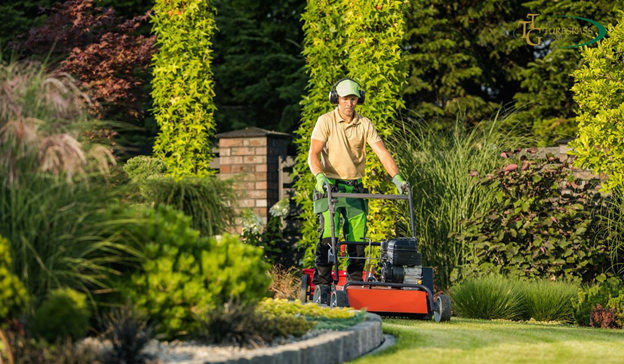Garden maintenance is the foundation of a vibrant, long-lasting outdoor space. A well-maintained garden not only adds aesthetic value to your home but also promotes biodiversity, supports local ecosystems, and enhances your mental well-being. Whether you’re a homeowner, a student of horticulture, or a casual gardener, understanding how to care for your garden throughout the seasons is essential.
Having spent over ten years helping clients with year-round Garden Maintenance strategies, I’ve seen how a consistent approach makes all the difference. Neglect during one season can cause long-term damage, while proactive care can lead to healthier plants, fewer pests, and a more enjoyable space overall.
Seasonal Garden Maintenance: A Year-Round Responsibility
- Maintaining a garden isn’t a one-time task; it’s a year-round responsibility that changes with the seasons. Spring, for example, is the time for pruning, fertilizing, and planting new blooms. This is when the garden awakens after winter, and early preparation sets the stage for the rest of the year. I often advise clients to invest in soil testing in early spring—it ensures your plants get the right nutrients from the start.
- In summer, garden maintenance involves regular watering, mulching to retain moisture, and pest control. The heat can stress plants, especially newly planted ones, so monitoring soil moisture is crucial. One of my personal lessons came from underestimating the power of deep watering—shallow watering may seem sufficient but leads to weaker root systems over time.
- Autumn is ideal for clearing fallen leaves, cutting back perennials, and preparing the soil for winter. This is also the best time to plant bulbs that will bloom in spring. A client of mine once transformed a tired autumn yard into a layered bulb garden, leading to a stunning, color-rich display the following spring. It showed how thoughtful autumn care can yield great rewards.
- Winter garden maintenance focuses more on protection. Covering sensitive plants, ensuring proper drainage, and pruning dormant trees are essential tasks. Even in colder months, gardens need attention—especially if you want to prevent soil erosion and damage from frost.
Best Practices for Effective Garden Maintenance
Healthy garden maintenance practices go beyond watering and weeding. One of the most overlooked aspects is soil health. Using organic compost regularly can enrich the soil, improve drainage, and encourage beneficial microorganisms. I’ve helped numerous clients switch from chemical fertilizers to composting, and the results are not only visible in plant health but also in reduced environmental impact.
Another key strategy is proper plant placement. Understanding the sunlight and moisture needs of each plant allows you to group them effectively. This minimizes overwatering and prevents competition for resources. Choosing native plants is also a smart choice—they’re naturally adapted to the local climate, require less maintenance, and support native wildlife.
Integrated pest management (IPM) is also gaining traction in garden maintenance. It promotes the use of natural predators and biological controls instead of chemical pesticides. I’ve personally used ladybugs to control aphids in herb gardens with great success. These methods keep your garden healthy without disrupting the ecosystem.
Smart Garden Maintenance in the Digital Age
In 2025, smart Garden Maintenance tools are revolutionizing how people care for their yards. Automated irrigation systems that adjust based on weather forecasts, mobile apps that track plant care schedules, and smart soil sensors make gardening more efficient and accessible. For beginners and busy homeowners, these tools provide valuable support without compromising results.
For academic readers, these innovations represent exciting intersections between technology and sustainability. Case studies have shown how using weather-adaptive irrigation reduces water use by over 30% compared to manual systems. These tools aren’t just trends—they’re part of a broader movement toward environmentally responsible landscaping.
FAQs About Garden Maintenance
How often should I water my garden?
The frequency depends on the season, plant type, and soil conditions. Generally, deep watering once or twice a week is more effective than frequent shallow watering. Using mulch can also help retain moisture and reduce the need for frequent irrigation.
What are the basic tools needed for garden maintenance?
Essential tools include pruning shears, a spade, a garden hose or watering can, a rake, and gloves. For larger gardens, consider adding a wheelbarrow, hedge trimmer, and compost bin to your toolkit.
Is it necessary to fertilize regularly?
Fertilizing helps plants get the nutrients they need, especially in poor soil conditions. Organic compost or slow-release fertilizers are ideal for providing balanced nutrition without damaging the soil ecosystem.
How do I prevent pests naturally?
Introduce beneficial insects like ladybugs or praying mantises, plant companion crops that repel pests, and keep your garden clean of debris where pests can breed. Neem oil and insecticidal soaps are also effective organic options.
Can I maintain a garden without experience?
Absolutely. Start small, choose easy-care plants, and follow a simple maintenance schedule. With time, you’ll gain confidence. There are also plenty of online guides, community workshops, and digital apps that can support beginners.
Conclusion
Garden maintenance is a blend of science, timing, and personal care. By understanding seasonal needs, using sustainable practices, and embracing modern tools, you can create and maintain a garden that thrives year-round. Whether you’re nurturing a small backyard garden or managing a larger landscape, the principles remain the same: consistency, observation, and respect for nature. As someone who’s seen gardens transform with the right approach, I can confidently say that maintaining your garden isn’t just about appearances—it’s about cultivating a space that brings joy, peace, and life to your environment.
